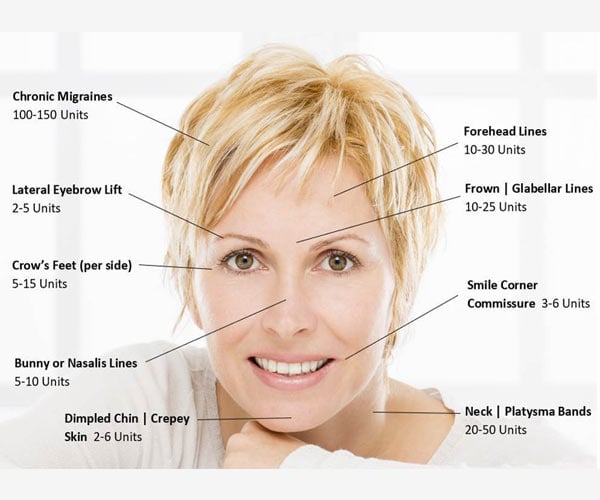Guide to Where to Get Botox® on the Face
By Dr. Stephen Cosentino
PRESIDENT OF EMPIRE MEDICAL TRAINING
A quick glance at a Botox face chart makes clear that Botox® is a versatile cosmetic treatment. It’s a relatively safe, effective, minimally invasive solution to a variety of cosmetic and musculoskeletal complaints.
According to Statista, plastic surgeons across the globe administered over 7.3 million Botox injections in 2022, solidifying its status as the most popular non-invasive aesthetic procedure globally.
It's important to understand the key areas where Botox can be injected on the face, as well as where it should be avoided. Let’s take a closer look at where to get Botox on the face — and where it’s not recommended.
Where to Get Botox on the Face: Key Areas
The most popular area on the face to get Botox is the forehead, but you’re by no means limited to that region.
These are the common Botox injection sites on the face. Each is associated with one or more cosmetic or musculoskeletal complaints:
- Forehead: Botox is a popular treatment for age-related forehead lines. Botox can be injected into the forehead in larger amounts to treat chronic migraine as well.
- Eyebrows: Small amounts of Botox can be injected into the area just above the eyebrow to achieve temporary brow lift. This can open up the eyes and create a more youthful, refreshed appearance.
- Glabella: Small amounts of Botox can relax the muscles between the eyes, reducing the appearance of glabellar lines (“11” lines).
- Corners of the Eyes: Botox can be injected around the eyes to reduce the wrinkles and fine lines known as crow’s feet.
- Nose: Botox isn’t injected on the bridge of the nose, but either side can be targeted to reduce the appearance of “bunny lines” (the horizontal wrinkles that appear when the nose is scrunched) and nasolabial folds.
- Corners of the Mouth: This area is targeted to reduce the appearance of frown lines and “sad smile” (marionette lines).
- Chin and Jawline: Botox can be injected into the chin to reduce the “orange peel” (dimpling) effect that’s a common sign of aging. It can be injected into the masseter (jaw) muscles to reduce square jaw and bruxism (teeth grinding).
- Platysma Muscles: This area is targeted to reduce the appearance of platysmal bands, the horizontal neck lines that deepen with age.
-
Neck (Platysmal Bands): While not technically the face, the horizontal neck lines known as platysmal bands can be treated with Botox injections to reduce their appearance.
Where to Avoid Botox Injections on the Face
There are plenty of places to avoid injecting Botox. Few regions of the face are off-limits, but it’s important to avoid certain areas altogether and to bypass certain structures elsewhere:
- Eyelids: Injecting Botox into the eyelids and the areas immediately around the eyelids can cause ptosis, or temporary eyelid droop.
- Epidermis: A shallow injection angle wastes Botox in the upper layer of the skin, where it can’t work its magic.
- Blood Vessels: Injecting Botox into blood vessels can cause serious complications, including major clots.
- Lips: Injecting Botox into the lips can cause bruising, swelling, and other unsightly side effects. Dermal fillers work better as lip injections.
- Specific Facial Muscles: Care must be taken to avoid muscles near the treatment area but not involved in the treatment plan. For example, injecting Botox into the depressor labii inferioris (DLI) muscle may cause temporary lip drooping.
Importance of an Experienced Provider
Given the complexity of Botox dosage and injection technique, it's crucial to have the treatment performed by an experienced, board-certified plastic surgeon, dermatologist, or other qualified medical professional. Attempting DIY Botox or going to an untrained injector can lead to unsatisfactory or even dangerous results.
When choosing a Botox provider, look for someone who has completed an accredited Botox certification course and has a proven track record of safe, natural-looking outcomes. Checking their credentials, reviewing before-and-after photos, and asking about their injection approach can help ensure you receive the best possible Botox experience.
Other Considerations and Contraindications
Botox is minimally invasive and, though not as long-lasting, it’s regarded as safer than traditional plastic surgery.
Still, any botulinum toxin treatment can result in side effects like:
- Severe bruising or discoloration around the injection site
- Temporary itching or redness around the injection site
- Temporary pain or numbness around the injection site
- Temporary eyelid drooping or crooked smile
More serious complications are rare, but important to watch for:
- Blood clotting events caused by injection into a blood vessel
- Systemic issues, such as urinary incontinence
And know that certain Botox side effects are more likely if you have certain medical conditions — so it’s important to disclose those during your initial consultation.
With the right provider and approach, Botox can be a transformative treatment that enhances your appearance while maintaining a refreshed, youthful, and authentic look. By following the guidance outlined in this article, you can make informed decisions about where to get Botox on your face and take the first step toward achieving your aesthetic goals.


